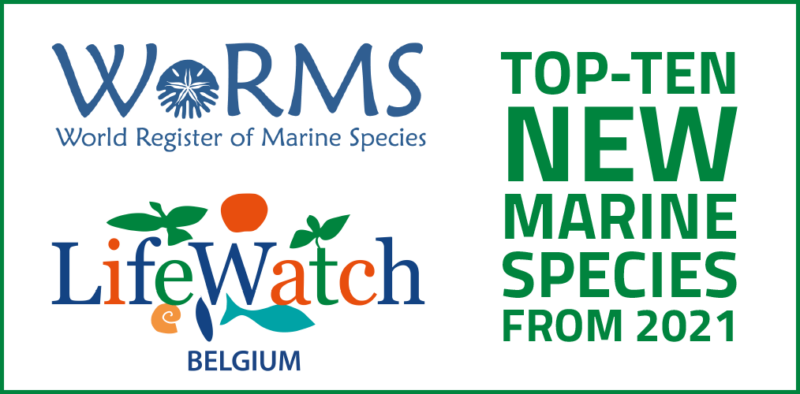
As in previous years, the World Register of Marine Species (WoRMS), an initiave hosted by VLIZ, LifeWatch Belgium‘s focal point, has released its annual list of its top-ten marine species described by researchers during the past year, marking World Taxonomist Appreciation Day on 19 March!
If you were unaware of this celebration of all the work that taxonomists do, you can find more here, here, and here.
The 2021 top-ten list is just a small highlight of over 2,000 fascinating new marine species discovered every year (there were 2,241 marine species described in 2021 and added to WoRMS, including 263 fossil species).
Full list:
- The Hidden Horniman Mysid, Heteromysis hornimani
- The Cebimar Moon Jellyfish, Aurelia cebimarensis
- The Emperor Dumbo, Grimpoteuthis imperator
- The Yokozuna Slickhead, Narcetes shonanmaruae
- The Quarantine Shrimp, Periclimenaeus karantina
- The Japanese Twitter Mite, Ameronothrus twitter
- The Jurassic Pig-Nose Brittle Star, Ophiojura exbodi
- Ramari’s Beaked Whale, Mesoplodon eueu
- The Balloon Backpack Isopod, Akrophryxus milvus
- Winter’s Basket Coccolithophore, Syracosphaera winteri
How were the species chosen?
A call for nominations was announced in December 2021, sent to all editors of WoRMS and editors of major taxonomy journals, and posted openly on the WoRMS website and social media so anyone had the opportunity to nominate their favourite marine species. Nominated species had to have been described in 2021, and come from the marine environment (including fossil taxa). A small committee (including both taxonomists and data managers) was brought together to decide upon the final candidates. The list is in no hierarchical order.
The final decisions reflect the immense diversity of animal groups in the marine environment (including fish, crustaceans, molluscs, corals, sponges, jellies and worms) and highlight some of the challenges facing the marine environment today. The final candidates also feature some particularly astonishing marine creatures, notable for their interest to both science and the public.
Each of these marine animals has a story. This year the chosen species range from the extremely tiny and often overlooked, to a new species of whale! Among the featured is the tiny Japanese Twitter Mite, discovered on social media, the Quarantine Shrimp, described during the COVID-19 lockdown, a new species of mysid hiding in plain sight, the massive Yokozuna Slickhead, honouring high ranking sumo wrestlers, and the astonishing Jurassic Pig-Nose Brittle Star!
About the WoRMS top-ten list of Marine Species
After 250 years of describing, naming and cataloguing the species we share our planet with, we are still some way off from achieving a complete census. However, we do know that at least 240,000 marine species have been described because their names are managed in WoRMS, by almost 300 scientists located all over the world.
WoRMS’ previous lists of the top-ten marine species described for the decade 2007–2017, for 2017, 2018, 2019 and 2020 can be found here:
- https://www.lifewatch.be/en/worms-top10-2007-2017
- https://www.lifewatch.be/en/worms-top10-2017
- https://www.lifewatch.be/en/worms-top10-2018
- https://www.lifewatch.be/en/worms-top10-2019
- https://www.lifewatch.be/en/worms-top10-2020
This news item was adapted from a post on LifeWatch Belgium.